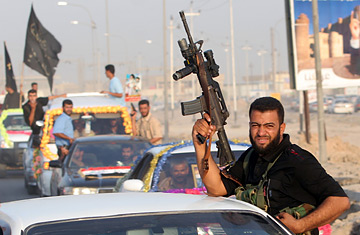
Mahdi Army militiamen celebrate the withdrawal of British troops from Basra in September.
In 2007 the United States military put its most dangerous enemy on the run. In 2008 it may face an even more entrenched foe. Al-Qaeda in Iraq (AQI), the primary target of the American troop surge and counter-insurgency strategy, appears to be on its last legs after a year of being attacked from all sides. But Shi'ite militias, which have deep roots in Iraq's Shi'a communities and the Shi'ite-dominated government, may now pose a more serious long-term threat.
In some ways AQI was a victim of its own success. It is practically the only organization in Iraq that all the other players in the country saw as an unacceptable threat. Both the U.S. military and the Shi'ite-dominated government had fought the Sunni jihadist group for years. By the beginning of 2007, Sunni tribal leaders and nationalist insurgents had also begun battling with their former allies in AQI in order to retake control of Sunni communities.
The extent to which forces have aligned against AQI was evident from General David Petraeus's comments at a year-end briefing for reporters in Baghdad's Green Zone. AQI has been the primary target of the American reinforcements brought to Iraq by the surge, and of the coordinated counter-insurgency strategy directed by Petraeus, who is the commander of the coalition forces in Iraq.
AQI fighters have also been chased out of their former strongholds in Anbar Province and west Baghdad by so-called Awakening Councils and Concerned Local Citizens — groups of Sunni leaders and fighters that now cooperate with the U.S. military. According to Petraeus, even neighboring Sunni Arab regimes have stepped up efforts to prevent militants from entering Iraq.
AQI remains a dangerous adversary for the American military and the Iraqi government. According to statistics released at Petraeus' press conference, suicide bombings — a favorite AQI tactic — declined significantly in 2007 but have been inching up again since October. On Saturday, Petraeus said that "the vast majority" of attacks in Iraq are still carried out by AQI. The beginning of 2008 brought a reminder of the dangers. On New Year's Day a suicide bombing killed at least 30 people in Baghdad; the target was a funeral for a man killed in a previous bombing.
"Although their capabilities have been diminished," Petraeus said of AQI, "you might liken them to a fighter who's been dropped to the canvas once or twice. That fighter keeps coming back off the canvas, has a very lethal right hand, and can land very tough blows."
Meanwhile, the Mahdi Army, Iraq's largest and deadliest Shi'ite militia, made it through 2007 by refusing to trade body blows with the American military. Petraeus, echoing other American officials, told reporters that "the potential long-term challenge to Iraq is the militia-extremist challenge." To keep the political peace in Iraq, Petraeus and the U.S. military have been careful not to attach the names of the Mahdi Army and its leader Moqtada al Sadr to the threat, hence the use of terms like "the militia-extremist challenge." Sadr controls a sizable political organization as well as his militia.
While Al-Qaeda in Iraq is now surrounded by enemies and has seen its base of support dry up, there has been no corresponding decline in the fortunes of militias like the Mahdi Army. Sadr declared a cease-fire at the end of August after his militia took the blame for fighting in the holy city of Karbala. But it retains its ability to fight other militias in southern Iraq. It is also still active in Shi'ite neighborhoods of Baghdad, even though its leaders have held back from fighting American troops for control of the streets. In fact, the cease-fire may have allowed Sadr to consolidate his fragmented and often unruly organization.
Meanwhile, Sadr's militia may be asserting mafia-like control over the poor Shi'ite areas where it has long provided the services and security the government has not. "What you do have is, the Mahdi Army, Inc.," said Petraeus, backing up an earlier assessment by U.S. Ambassador Ryan Crocker. The militia has come to dominate not simply by force, but also by controlling staples like fuel and electricity.
Thus, in contrast to AQI, the Mahdi Army enters 2008 with its military capability and its base of support largely intact. If the political or military dynamic changes in 2008, the militia's leadership could just as easily choose to once again unleash its fighters. By mid-summer the surge will be over, and U.S. troop strength will be back where it was in late 2006. So, if the cease-fire does end, the U.S. will not be fighting with the 30,000 reinforcements that contributed to the gains of 2007. It will also face an adversary with strong support in Shi'ite communities and elements of the Iraqi government. At that point it may be the U.S., rather than its foe, that will have to make a tough choice about whether it can or should continue to fight.
